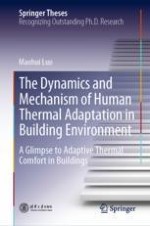2020 | OriginalPaper | Buchkapitel
2. Indoor Climate Experience and Thermal Comfort Expectation in Buildings
verfasst von : Maohui Luo
Erschienen in: The Dynamics and Mechanism of Human Thermal Adaptation in Building Environment
Verlag: Springer Singapore
Aktivieren Sie unsere intelligente Suche, um passende Fachinhalte oder Patente zu finden.
Wählen Sie Textabschnitte aus um mit Künstlicher Intelligenz passenden Patente zu finden. powered by
Markieren Sie Textabschnitte, um KI-gestützt weitere passende Inhalte zu finden. powered by
